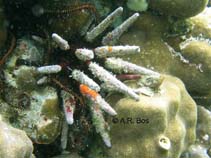Phyllacanthus imperialis Lamarck, 1816
Lance urchinWarning: DOMDocument::load(): SSL operation failed with code 1. OpenSSL Error messages: error:140770FC:SSL routines:SSL23_GET_SERVER_HELLO:unknown protocol in C:\Apache24\htdocs\includes\SpeciesSummary.lib.php on line 1236
Warning: DOMDocument::load(): Failed to enable crypto in C:\Apache24\htdocs\includes\SpeciesSummary.lib.php on line 1236
Warning: DOMDocument::load(https://sealifebase.nrm.se/webservice/AquaMaps/getAMap.php?genus=Phyllacanthus&species=imperialis): failed to open stream: operation failed in C:\Apache24\htdocs\includes\SpeciesSummary.lib.php on line 1236
Warning: DOMDocument::load(): I/O warning : failed to load external entity "https://sealifebase.nrm.se/webservice/AquaMaps/getAMap.php?genus=Phyllacanthus&species=imperialis" in C:\Apache24\htdocs\includes\SpeciesSummary.lib.php on line 1236
Classification / Names Common names | Synonyms | CoL | ITIS | WoRMS
| Cidaroida | Cidaridae
Environment: milieu / climate zone / depth range / distribution range экология
ассоциированный с рифами; пределы глубины 0 - 15 m (Ref. 800). Tropical
распространение страны | регионы FAO | Ecosystems | места находок | интродукции
Indo-West Pacific: East Africa and the Red Sea to Australia and Japan.
Length at first maturity / Size / Вес / Возраст
Maturity: Lm ? range ? - ? cm Max length : 7.0 cm WD самец/пол неопределен; (Ref. 800)
Maximum primary spine length: 8.0 cm. Inhabits shallow reef areas at depths of 0 to 15 m. Hides in holes or under corals at day time (Ref. 800); and burrows in coral rock (Refs. 81254, 129602). Feeds on algae and small invertebrates (Ref. 800). Associated with coral communities. Nocturnal. Feeds on encrusting organisms (Ref. 129602).
Life cycle and mating behavior половая зрелость | размножение | нерест | икра | Fecundity | личинки
Members of the class Echinoidea are gonochoric. Fertilization is external. Brooding is common, eggs are held either on the peristome, around the periproct or deep into the concavities on the petaloids. Life cycle: Embryos develop into planktotrophic larvae (echinoplateus) and live for several months before they sink to the bottom using their tube feet to adhere on the ground where they metamorphose into young urchins.
Основная ссылка
ссылки | координатор | соавторы
Schoppe, S. 2000. (Ref. 800)
Статус Красного Списка МСОП (Ref. 130435)
Статус СИТЕС (Ref. 108899)
Not Evaluated
CMS (Ref. 116361)
Not Evaluated
Угроза для людей
Harmless
Использование человеком
| FishSource |
инструменты
дополнительная информация
Возраст/Размеры
рост
Зависимость между длиной и массой тела
Зависимость между длинами
морфология
личинки
численность
рост
Зависимость между длиной и массой тела
Зависимость между длинами
морфология
личинки
численность
ресурсы в Интернет
BHL | BOLD Systems | CISTI | DiscoverLife | FAO(Publication : search) | Fishipedia | GenBank (Геном, Нуклеотид) | GloBI | Gomexsi | Google Books | Google Scholar | Google | PubMed | Tree of Life | Wikipedia (Вперёд, поиск) | Zoological Record
Estimates based on models
Preferred temperature
(Ref. 115969): 22.6 - 29.3, mean 28.2 (based on 2492 cells).
Категория цены
(Ref. 80766):
Unknown.



